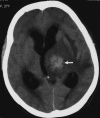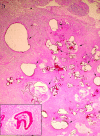Cerebral alveolar echinoccosis mimicking primary brain tumor
- PMID: 16484422
- PMCID: PMC8148798
Cerebral alveolar echinoccosis mimicking primary brain tumor
Abstract
We present a case of cerebral infestation by Echinococcosis multilocularis mimicking an infiltrative primary brain tumor. A heavily calcified mass invading the midbrain enhanced in a cauliflower-like fashion with small peripheral nodules present on MR imaging. Perfusion-weighted MR imaging revealed low relative cerebral blood volume within the calcified lesion and peripheral hyperemia. Single-voxel proton MR spectroscopy with an echo time of 135 milliseconds was normal.
Figures




Similar articles
-
Thalamic hydatid cyst: contrast-enhanced MR imaging findings.Comput Med Imaging Graph. 1996 Sep-Oct;20(5):395-8. doi: 10.1016/s0895-6111(96)00055-9. Comput Med Imaging Graph. 1996. PMID: 9007367
-
Magnetic resonance spectroscopy and magnetic resonance imaging findings of the intracerebral alveolar echinococcosis.J Craniofac Surg. 2014 Jul;25(4):1352-3. doi: 10.1097/SCS.0000000000000815. J Craniofac Surg. 2014. PMID: 25006915
-
Cerebral Alveolar Echinococcosis Concomitant with Liver and Lung Lesions in a Young Adult Patient: Case Report and Literature Review.Turkiye Parazitol Derg. 2016 Sep;40(3):169-171. doi: 10.5152/tpd.2016.4624. Turkiye Parazitol Derg. 2016. PMID: 27905289
-
Neurohydatidosis.Australas Radiol. 2007 Oct;51(5):406-11. doi: 10.1111/j.1440-1673.2007.01860.x. Australas Radiol. 2007. PMID: 17803790 Review.
-
Parasitic diseases of the central nervous system.Neuroimaging Clin N Am. 2011 Nov;21(4):815-41, viii. doi: 10.1016/j.nic.2011.07.005. Epub 2011 Sep 3. Neuroimaging Clin N Am. 2011. PMID: 22032501 Review.
Cited by
-
Multimodality imaging in diagnosis and management of alveolar echinococcosis: an update.Diagn Interv Radiol. 2016 May-Jun;22(3):247-56. doi: 10.5152/dir.2015.15456. Diagn Interv Radiol. 2016. PMID: 27082120 Free PMC article. Review.
-
Role of magnetic resonance spectroscopy and susceptibility weighted imaging in cerebral alveolar echinococcosis.Iran J Parasitol. 2015 Jan-Mar;10(1):122-7. Iran J Parasitol. 2015. PMID: 25904955 Free PMC article.
-
Primary calcified hydatid cyst of the brain.J Neurosci Rural Pract. 2010 Jul;1(2):115-7. doi: 10.4103/0976-3147.71729. J Neurosci Rural Pract. 2010. PMID: 21808518 Free PMC article.
-
The value of nomogram based on MRI functional imaging in differentiating cerebral alveolar echinococcosis from brain metastases.Eur J Med Res. 2024 Oct 17;29(1):499. doi: 10.1186/s40001-024-02064-3. Eur J Med Res. 2024. PMID: 39415299 Free PMC article.
-
Clinical Features, Radiological Characteristics, and Outcomes of Patients With Intracranial Alveolar Echinococcosis: A Case Series From Tibetan Areas of Sichuan Province, China.Front Neurol. 2021 Jan 15;11:537565. doi: 10.3389/fneur.2020.537565. eCollection 2020. Front Neurol. 2021. PMID: 33519658 Free PMC article.
References
-
- Ammann RW, Eckert J. Echinococosus. Gastroenterol Clin North Am 1996;25:655–89 - PubMed
-
- Kammerer WS. Echinococcosis affecting the central nervous system. Semin Neurol 1993;13:144–47 - PubMed
-
- Bresson-Hadni S, Vuitton DA, Bartholomot B, et al. Twenty-year history of alveolar echinococcosis: analysis of a series of 117 patients from eastern France. Eur J Gastoenterol Hepatol 2000;12:327–36 - PubMed
-
- Gomori JH, Cohen D, Eyd A, et al. Water lily sign in CT of cerebral hydatid disease: a case report. Neuroradiology 1988;30:358. - PubMed
-
- Haliloglu M, Saatci I, Akhan O, et al. Spectrum of imaging findings in pediatric hydatid disease. AJR Am J Roentgenol 1997;169:1627–31 - PubMed
Publication types
MeSH terms
LinkOut - more resources
Full Text Sources
Medical
